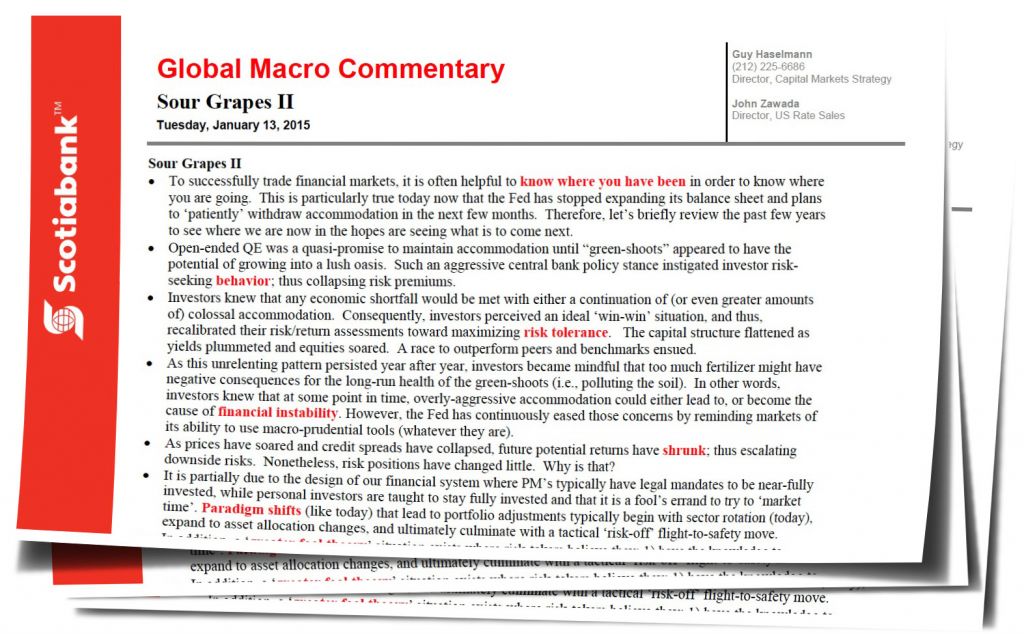by Kara Lilly, Investment Strategist, Mawer Investment Management
My colleague James spent time with some distressed debt investors last week. Now, as a bond investor, James is already less positive and more cynical than the stereotypical equity manager. But these distressed debt investors—those who focus their attention on companies near bankruptcy—took typical bond orneriness to a whole new level.
One gentleman in particular was a wellspring of wonderful lessons, delivered in punchy quotes and the kind of thick New York accent in which all “O”s become “A”s. Since we think his insights are too excellent not to share, we have listed five of our favourites below.
1. “You lend to companies, but people pay you back.”
Debt is often treated as a highly technical area of investing, but it is the people behind companies that truly matter. A company might have excellent cash flows and a great business model, but decisions are ultimately made by people. Management decides whether to invest in a capital expansion program, hire new employees, raise the dividend, increase salaries or pay back debt. Management controls capital allocation, budgets and culture. Any evaluation of a company’s creditworthiness is therefore inextricably tied to the people running the show.
2. “Good management is the face of problems.”
The context for this lesson is that a good management team is open in thought and communication when addressing problems with investors, while a bad management team tends to hide them.
Teams that are open with their challenges can communicate constructively with investors, allowing shareholders and debt holders the opportunity to understand, and therefore better evaluate, the risk in a situation. A high level of transparency allows stakeholders to develop trust in a management’s integrity. It also reduces the likelihood of major, negative surprises in the market. For example, SNC Lavalin senior management seemingly knew long before it was publicly announced that corruption was a major challenge within the organization, but chose to hide the issue anyway; at least, until it no longer could be ignored. This led to a major PR crisis and gave investors (like us) reason to doubt in management (it is positive that the team that replaced the old guard have adopted a much more transparent approach).
3. “Never bet your career on downloaded financial statements.”
Anyone who has much spent time digging through financial statements knows how fraught with manipulation they can be. And yet many investors take financial statements at face value. This is risky, as management teams often “massage” their quarterly figures, exaggerate facts, downplay risks or write-downs, or carefully select which metrics they report. Even teams with strict financial integrity tend to story tell in their annual reports. And this doesn’t even consider the outright fraud that exists.
As a stark reminder why one should never have “faith” in financial statements, consider the case of Gowex, a fraudulent company originally listed on the Spanish stock exchange. Gowex went from being a European technology darling to a disgraced fraud within five months, following a report by Gotham City research that accused the company of doctoring over 90% of its revenues. Obviously, many of the assertions in the company’s financials were not accurate—and some even smelled foul enough that it was possible for external parties to raise red flags (not always easy in the case of frauds).
[The report is a worthy read for any investor. It illuminates how far teams can go in manipulating statements and provides inspiration on the kind of prudent fact-checking that is required before making an investment in any company].4. “I love liquidity, liquidity is my favourite thing.”
This quote is one of our favourites, as it was said with enough gusto that one might have thought the topic was Christmas. It is also interesting because it casts light on the relevance of liquidity in difficult times.
Liquidity within investing is a measure of how much trading exists for a bond or a stock. The more liquidity there is, the narrower the range in the asset’s buying and selling price, and the easier it is to quickly convert that asset to cash. Therefore, a highly liquid asset has a high degree of trading activity around it and can usually be bought or sold in the market without affecting its price. If it is illiquid, a single trade can push the market price up or down.
When bond holders place a high value on liquidity, it is because they know the downfalls of illiquid markets. When liquidity deteriorates in an asset, investors can’t sell out of their position, and they get stuck holding onto bonds that they really don’t want and large losses can accumulate. That’s why James’ companion was making such a fuss about liquidity when it comes to distressed debt (a riskier asset). When the market is performing well and credit spreads are tight, it seems less risky to hold higher-yielding debt instruments with poor liquidity. But if sentiment turns which generally lowers liquidity, the net result is often a lot of pain. Exposure to illiquid securities needs to be actively managed through the cycle.
5. “Every once in a while, it is like the rooster taking credit for the sunrise.”
While this quotation isn’t an original—Al Gore once said that “George Bush taking credit for the Berlin Wall coming down is like the rooster taking credit for the sunrise”—it remains a classic… especially as it pertains to the idea of “bull market genius.”
This quote relates to the human tendency to take responsibility for good outcomes, even when our decisions had nothing to do with the positive results. We see this all the time in bull markets when everyone imagines that they are geniuses because the stocks or bonds they selected are doing well. But nearly everyone does well in a bull market. What matters is not how easy it is to ride the wave when the tide is going your way, but what happens when the tide goes out.
This idea is especially relevant given what we are seeing now in debt markets. Bonds have essentially spent the last two decades rallying, as interest rates fell structurally lower and lower. Now bonds benefit from lower inflation expectations and uncertainty of global growth, which has continued to stimulate investor demand. Yet the pervasive demand for bonds has blinded some investors to the fact that not all credit is created equal. In recent times, we have seen a growing demand for higher-yielding, but ultimately riskier, debt products, issued by companies that have increasingly lowered the standard of covenants in their issuance—a trend that is bad for debt holders as it reduces the credit protection. Yet these bonds have done rather well given the environment. But does this mean these investors are geniuses? Not likely. Rather, many of these investors will experience unanticipated losses when the bottom eventually falls out of the credit market again.
Kara Lilly, CFA
Investment Strategist
Copyright © Mawer Investment Management















